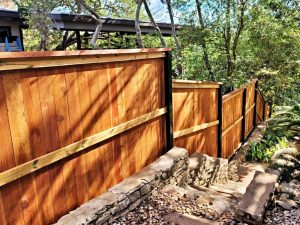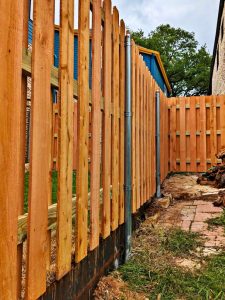TL;DR
Under Texas fence law, property owners must understand who owns a fence, who’s responsible for maintenance, and who’s liable for damage or injury. Generally, fences along a property line are jointly owned, and both neighbors share the costs of upkeep. However, liability for damage, removal, or injury depends on ownership, negligence, and compliance with local regulations. Consulting professionals like Austin Fence Contractor ensures your fence meets state law, city code, and HOA requirements.
Why Texas Fence Laws Matter
 Whether you live in downtown Austin or rural Travis County, Texas, fence laws exist to protect property rights, promote safety, and prevent disputes.
Whether you live in downtown Austin or rural Travis County, Texas, fence laws exist to protect property rights, promote safety, and prevent disputes.
Fences define ownership boundaries, maintain privacy, and secure animals or property. But when they’re built incorrectly or damaged, liability can fall on you — even if you didn’t cause the issue.
Understanding Texas fence law helps you:
- Avoid neighbor disputes
- Prevent legal or financial liability.y
- Ensure your fence complies with city or HOA regulations.s
- Protect your investment in your home or property.
A compliant fence starts with knowing who owns it, who’s responsible for it, and what to do if it causes a problem.
Who Owns the Fence? Understanding Property Boundaries
Ownership depends on where the fence is built.
- If a fence sits entirely on one property, that property owner owns and maintains it.
- If a fence sits directly on the property line, ownership is typically shared equally between neighbors.
- If one neighbor builds the fence on the shared boundary without consent, ownership is disputed until resolved legally or by written agreement.
To confirm ownership, request a land survey before construction. This avoids disputes over encroachment — a frequent issue addressed in our post, Fence Height and Property Line Rules in Austin.
Shared Fences and Maintenance Responsibilities
Texas law follows the “good neighbor” principle — shared fences mean shared responsibility.
If You Both Benefit from the Fence:
- Both property owners are jointly responsible for repairs and maintenance.
- Costs are usually split 50/50, unless a different agreement exists.
If One Party Causes Damage:
- That party must pay for the repair or replacement.
- You can seek reimbursement through civil court if they refuse.
If you’re unsure how to divide costs, put the agreement in writing and have both parties sign it.
For expert assistance, our Fence Repair and Fence Replacement teams help homeowners repair shared fences while keeping both parties satisfied and compliant.
Fence Damage and Liability in Texas
 Fence liability often depends on fault and negligence — not just ownership.
Fence liability often depends on fault and negligence — not just ownership.
Here’s how Texas law typically handles different scenarios:
| Situation | Who’s Liable | Legal Notes |
| Storm or natural damage | No one (Act of God) | Insurance may cover repair costs. |
| Damage caused by a neighbor | The neighbor | Must pay for repair or replacement. |
| Fence collapse causing injury | Fence owner | Liable if poor maintenance or neglect is proven. |
| The fence violates the code or encroaches | Fence builder | May face fines or removal orders. |
A well-built, properly permitted fence significantly reduces liability risk. You can learn more about Austin’s permit process in How to Get a Fence Permit in Austin.
Livestock and Rural Fence Laws
Texas has unique “open range” and “fence-in” laws that affect landowners outside urban areas.
Open Range Rule
In rural parts of Texas, livestock owners aren’t automatically responsible for animals that wander onto roads — unless the county has adopted “fence-in” laws.
Fence-In Rule (Most Counties)
Under “fence-in” regulations (including Travis and Williamson counties), livestock owners must:
- Build and maintain secure fences to keep animals contained.
- Repair broken sections promptly to prevent damage or injury.
- Pay for damages caused by escaped livestock.
If your property borders agricultural land, proper fence design and materials matter — both legally and practically. Our Fence Installation service ensures your structure meets Texas Agricultural Code standards.
Permits, HOAs, and City Ordinances
 Even though fence law is governed at the state level, local regulations in Austin and surrounding areas set specific rules for:
Even though fence law is governed at the state level, local regulations in Austin and surrounding areas set specific rules for:
- Fence height (typically 6 feet residential, 8 feet commercial)
- Visibility triangles at intersections
- Setback distances from sidewalks and easements
- HOA design and material restrictions
Ignoring these can lead to city fines or forced removal, as explained in What Happens If You Install a Fence Without a Permit in Austin.
Before starting any fence project, check both:
- City of Austin Development Services Department (DSD) for permit requirements.
- Your HOA’s architectural committee for aesthetic guidelines.
Resolving Fence Disputes Legally
When disagreements arise, Texas law favors peaceful resolution first. Here’s the recommended legal process:
- Start with Communication
- Talk to your neighbor calmly and present property surveys or references to the city code.
- Document Everything
- Take photos, write down dates, and keep records of any agreements.
- Mediation
- The Austin Dispute Resolution Center (ADRC) can mediate neighbor conflicts affordably.
- Legal Action (Last Resort)
- If property damage or encroachment persists, file a small claims case in Travis County.
- Courts can order the removal of a fence, reimbursement of repair costs, or clarification of property boundaries.
- If property damage or encroachment persists, file a small claims case in Travis County.
For a complete step-by-step guide, see our blog How to Handle Fence Disputes with Neighbors Legally.
How to Stay Compliant with Texas Fence Laws
Staying compliant is easier than you think when you plan carefully and hire professionals.
Here’s a quick checklist:
- ✅ Verify property lines before building
- ✅ Obtain permits when required
- ✅ Use HOA-approved materials and designs
- ✅ Maintain your fence regularly
- ✅ Document agreements for shared fences
- ✅ Hire experienced contractors who understand both state law and the Austin city code
Austin Fence Contractor combines legal compliance with craftsmanship, ensuring every project meets both Texas law and local regulations.
Frequently Asked Questions (FAQ)
1. Who owns the fence between two properties in Texas?
If a fence lies directly on the property line, both neighbors share ownership and maintenance responsibility unless stated otherwise in writing.
2. Who pays for fence repairs in Texas?
Shared fences are typically repaired jointly. If one party causes damage, they are responsible for all related costs.
3. Can I remove or replace a shared fence without my neighbor’s permission?
No. Removing or altering a shared fence requires mutual consent, or you risk civil liability.
4. What happens if my fence injures someone or damages property?
You could be held legally liable if negligence or unsafe construction is proven.
5. Are there specific Texas laws for livestock fences?
Yes. In rural “fence-in” counties, livestock owners must build secure enclosures and are liable for escaped animals that cause harm or damage.
Conclusion
Texas fence law balances private property rights with shared responsibility. Whether you’re dealing with a city code issue, HOA rules, or rural boundary maintenance, understanding your legal duties prevents costly disputes.
For compliant fence design, installation, or repair — handled legally and professionally — trust Austin Fence Contractor. We ensure every fence meets Texas standards while protecting your property and your peace of mind.


Recent Comments